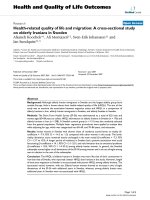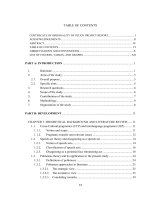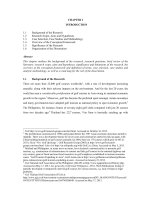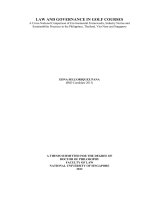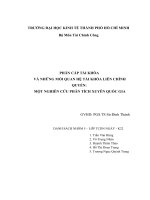Possession and ownership a cross linguistic typology
Bạn đang xem bản rút gọn của tài liệu. Xem và tải ngay bản đầy đủ của tài liệu tại đây (1.27 MB, 342 trang )
Tai Lieu Chat Luong
Possession and Ownership
E X P L O R A TI O N S I N L I N G U I S TI C T Y P O L O G Y
GENERAL EDITORS:
Alexandra Y. Aikhenvald and R. M. W. Dixon
Cairns Institute, James Cook University
This series focuses on aspects of language that are of current theoretical interest and
for which there has not previously or recently been any full-scale cross-linguistic
study. Its books are for typologists, fieldworkers, and theory developers, and designed for use in advanced seminars and courses.
PUBLISHED
1 Adjective Classes
edited by
R. M. W. Dixon and Alexandra Y. Aikhenvald
2 Serial Verb Constructions
edited by
Alexandra Y. Aikhenvald and R. M. W. Dixon
3 Complementation
edited by
R. M. W. Dixon and Alexandra Y. Aikhenvald
4 Grammars in Contact
edited by
Alexandra Y. Aikhenvald and R. M. W. Dixon
5 The Semantics of Clause Linking
edited by
R. M. W. Dixon and Alexandra Y. Aikhenvald
6 Possession and Ownership
edited by
Alexandra Y. Aikhenvald and R. M. W. Dixon
P U B L I S H E D I N A S S O C I AT I O N W I T H T H E S E R I E S
Areal Diffusion and Genetic Inheritance
Problems in Comparative Linguistics
edited by
Alexandra Y. Aikhenvald and R. M. W. Dixon
Possession and
Ownership
A Cross-Linguistic Typology
Edited by
ALE XAND R A Y. A IK HE NVALD and
R. M. W. DIXON
Cairns Institute
James Cook University
1
3
Great Clarendon Street, Oxford, OX2 6DP,
United Kingdom
Oxford University Press is a department of the University of Oxford.
It furthers the University’s objective of excellence in research, scholarship,
and education by publishing worldwide. Oxford is a registered trade mark of
Oxford University Press in the UK and in certain other countries
# Editorial matter and organization Alexandra Y. Aikhenvald and R. M. W. Dixon 2013
# The chapters their several authors 2013
The moral rights of the authors have been asserted
First Edition published in 2013
Impression: 1
All rights reserved. No part of this publication may be reproduced, stored in
a retrieval system, or transmitted, in any form or by any means, without the
prior permission in writing of Oxford University Press, or as expressly permitted
by law, by licence or under terms agreed with the appropriate reprographics
rights organization. Enquiries concerning reproduction outside the scope of the
above should be sent to the Rights Department, Oxford University Press, at the
address above
You must not circulate this work in any other form
and you must impose this same condition on any acquirer
British Library Cataloguing in Publication Data
Data available
ISBN 978–0–19–966022–3
Printed in Great Britain by
MPG Books Group, Bodmin and King’s Lynn
Contents
Preface
Notes on the contributors
Abbreviations
1 Possession and ownership: a cross-linguistic perspective
Alexandra Y. Aikhenvald
1 Preamble
2 Meanings and forms in possessive noun phrases
3 Beyond a noun phrase: possession within a clause
4 Possessive marking in its further uses
5 Possession and language contact
6 Possession in grammar and society
7 Possession and ownership: what can we conclude?
8 About this volume
References
2 Ownership, part–whole, and other possessive–associative relations in
Nêlêmwa (New Caledonia)
Isabelle Bril
1 General characteristics of Nêlêmwa
2 Possessive constructions with animates
3 Part–whole and other relations with inanimate determiners
4 Possessive determination of nominalizations
5 Relational determination of quantifiers
6 Possession within a clause: possessive predication
7 To conclude
References
3 Possession in Moskona, an East Bird’s Head language
Gloria J. Gravelle
1 Possession in Moskona
2 The Moskona language
3 Core types of possessive relationships
4 Possession in noun phrases
5 Possession expressed by a clause
6 External possession
ix
xi
xv
1
1
2
27
41
45
46
52
54
57
65
66
70
74
83
84
85
87
88
90
90
90
91
91
100
105
vi
Contents
7 Possession and language contact
8 Possession in society
References
4 Possession and ownership in Manambu, a Ndu language from the
Sepik area, Papua New Guinea
Alexandra Y. Aikhenvald
1 The Manambu and their possessions
2 The Manambu language: a typological snapshot
3 Meanings and forms of possessive noun phrases
4 Possession within a clause
5 Intangible possessions: clans, totems, and names
6 Possession in grammar and society
References
5 Possession in Martuthunira
Alan Dench
1 Meanings and forms of nominal possessive constructions
2 Kinship relations
3 Part–whole
4 Verbal coding of possession
5 Cultural patterns
References
6 Possession in Nanti
Lev Michael
1 Introduction
2 Sociolinguistic and and typological background
3 Possession in the noun phrase
4 Possession in the verb phrase
5 Possession-like constructions: part–whole classifier constructions
6 Culture contact and possession
References
7 Possession and association in Galo language and culture
Mark W. Post
1 Introduction
2 Possession in the noun phrase: the Genitive
3 Predicative possession
4 Possession and ownership in Galo culture
5 Possession or association? An evolutionary perspective
References
105
106
106
107
107
108
109
117
120
124
125
126
127
140
144
146
147
148
149
149
149
150
158
164
165
166
167
167
167
175
182
183
184
Contents
8 Possessive constructions in Mandarin Chinese
Yongxian Luo
1 Introduction
2 Possessive constructions and possessive marking in Chinese
3 Possessives, classifiers, demonstratives, and definiteness
4 Possession within the clause
5 Possession in morpho-syntax, lexicon, and society
6 Summary
References
9 Possession in Hone
Anne Storch
1 Introduction
2 Nominal possession
3 Predicative possession
4 Summary
References
10 Possessive constructions in Likpe (SEkpElé)
Felix K. Ameka
1 Introduction
2 Likpe: the language and its speakers
3 Nominal possessive constructions
4 Predicative possessive constructions
5 Contact and areal dimensions
6 Concluding remarks
References
11 Possession in Wandala
Zygmunt Frajzyngier
1 Introduction
2 Relational modification
3 Modification of non-relational constituents
4 Modification of relational nouns
5 Nominal modification of relational nouns
6 Definiteness of the head with the third-person pronoun
7 Possessive predication
8 Possessive interpretations of existential predications
9 Conclusions
References
vii
186
186
187
193
195
200
204
204
208
208
210
219
222
223
224
224
226
229
237
239
240
241
243
243
245
246
251
254
255
256
258
260
260
viii
Contents
12 Spirits of the forest, the wind, and new wealth: defining some of
the possibilities, and limits, of Kamula possession
Michael Wood
1 Some mainly Melanesian arguments about possession
2 Possession, spirits, and sources
3 The Kamula and their language
4 Person, place, and possession
5 Fathers
6 Aiyalma and edging toward exclusive possession
7 Climate change, clean wind, and oil as theft
8 Conclusion
References
13 Being and belonging: exchange, value, and land ownership in the
Western Highlands of Papua New Guinea
Rosita Henry
1 Introduction
2 Temboka
3 Principles of social organization and land tenure in the Nebilyer Valley
4 Linguistic dimensions of possession and ownership
5 The ‘Segmentary Person’
6 The Ganiga and their neighbour, Joe Leahy
7 Conclusion
References
261
261
263
264
265
266
268
269
271
272
274
274
276
277
278
282
283
288
289
14 Possession and also ownership—vignettes
R. M. W. Dixon
1 Comitative and privative used for predicative possession
2 Possessor as head of an inalienable construction
3 What can be possessed, and owned
References
291
294
302
308
Index of authors
Index of languages, language families, linguistic areas, and ethnic groups
Index of subjects
309
313
316
291
Preface
Every language has a way of expressing possessive relationships. The marking and the
conceptualization of these vary across languages and cultures. This volume aims at
investigating the varied facets of possession and associated notions.
The volume starts with a typological introduction outlining the marking, and the
meaning, of possession within a noun phrase, a clause, and a sentence, focusing on
correlations between possessive structures, and cultural and social aspects of its
conceptualization by speakers. It is followed by revised versions of thirteen of the
fifteen presentations from the International Workshop ‘Possession and Ownership’,
held at the Language and Culture Research Group, the Cairns Institute, James Cook
University, 27 September–2 October 2010. An earlier version of Chapter 1 had been
circulated to the contributors, with a list of points to be addressed, so as to ensure that
their detailed studies of individual languages were cast in terms of a common set of
typological parameters.
The week of the Workshop was an intellectually stimulating and exciting time, full
of discussions and cross-fertilization of ideas. The authors have all undertaken
intensive fieldwork, in addition to having experience of working on linguistic typology, historical comparative issues, and problems of areal diffusion. The analysis is
cast in terms of basic linguistic theory—the cumulative typological functional framework in terms of which almost all descriptive grammars are cast—and avoids
formalisms (which provide reinterpretations rather than explanations, and come
and go with such frequency that any statement made in terms of them is likely to
soon become inaccessible).
It is our hope that this volume will provide a consolidated conceptual and analytic
framework covering the major parameters of variation in the expression of possession across the world, and how it correlates with cultural parameters.
We are grateful to all the participants in the Workshop who took part in the
discussion and provided feedback on presentations at various stages—Ton Otto,
Chia-jung Pan, Dineke Schokkin, Borut Telban, Daniela Vavrová, and Sihong
Zhang. We owe a special debt of gratitude to Brigitta Flick and Elena Rhind, for
helping us organize the Workshop in a most efficient manner. Brigitta Flick’s
editorial assistance was, as always, invaluable.
The Workshop was made possible through a grant from the International
Science Linkages—Humanities and Creative Arts Programme (ISL–HCA), awarded
to Aikhenvald by the Australian Academy of the Humanities. We also gratefully
x
Preface
acknowledge financial assistance from the Faculty of Arts and Social Sciences and
from the Cairns Institute at James Cook University.
As with previous volumes emanating from our International Workshops (also
published in the series Explorations in Linguistic Typology), we owe a considerable
debt to John Davey, our editor at Oxford University Press. His indomitable support
makes volume editors, and their book, feel wanted.
Notes on the contributors
ALEXANDRA Y. AIKHENVALD is Distinguished Professor and Tropical Leader (People and
Societies of the Tropics) and Director of the Language and Culture Research Centre
in the Cairns Institute and School of Arts and Social Sciences of James Cook
University. She has worked on descriptive and historical aspects of Berber languages
and has published, in Russian, a grammar of Modern Hebrew (1990). She is a major
authority on languages of the Arawak family, from northern Amazonia, and has
written grammars of Bare (1995, based on work with the last speaker who has since
died) and Warekena (1998), plus A grammar of Tariana, from northwest Amazonia
(Cambridge University Press, 2003; paperback 2007), in addition to essays on various
typological and areal features of South American languages. Her lengthy grammar,
The Manambu language from East Sepik, Papua New Guinea, was published by
Oxford University Press in 2008 (paperback 2010). Other monographs with OUP
are Classifiers: a typology of noun categorization devices (2000, paperback 2003),
Language contact in Amazonia (2002, paperback 2010), Evidentiality (2004, paperback 2006), Imperatives and commands (2010, paperback 2012) and Languages of the
Amazon (2012). Address: The Cairns Institute, James Cook University, PO Box 6811,
Cairns, NQld 4780, Australia; e-mail:
FELIX K. AMEKA teaches African Linguistics at Leiden University, and is a Visiting
Researcher of the Language and Cognition Group, Max Planck Institute for Psycholinguistics, Nijmegen, the Netherlands. His interests are in language description/
documentation, typology, semantics, pragmatics, contact, areal and anthropological
linguistics, ethnography of communication, and West African languages. He
has numerous publications on these topics. He has also (co-)edited volumes on
grammar-writing, locative predication, tense–aspect-modality, Ghanaian linguistics,
and interjections. Currently, he is documenting Likpe language and culture (Ghana)
and preparing a pan-dialectal grammar of Ewe (with James Essegbey). He is Editorin-Chief of the Journal of African Languages and Linguistics. Address: Department
of African Languages and Cultures, LUCL, Faculty of the Humanities, University
of Leiden, P.N. van Eyckhof 3, 2311 BV, Leiden; The Netherlands; e-mail:
ISABELLE BRIL is Senior researcher at CNRS-LACITO (Laboratoire des Langues et
Civilisations à Tradition orale) in Paris. Her research interests centre on the syntax,
semantics, and typology of Oceanic and Austronesian languages. She has done
fieldwork on Kanak languages in New Caledonia. Her main publications are a
dictionary Dictionnaire nờlờmwa-nixumwak-franỗais-anglais (Peeters 2000) and a
xii
Notes on the contributors
grammar of Nêlêmwa Le nêlêmwa (Nouvelle-Calédonie): Analyse syntaxique et sémantique (Peeters, 2002). She is the editor with Ozanne-Rivierre of a volume on
Complex predicates in Oceanic languages: studies in the dynamics of binding and
boundedness (Mouton de Gruyter, 2004) and editor of a volume on Clause-linking
and clause hierarchy: syntax and pragmatics. (SLC 121, Benjamins, 2010). Address:
CNRS-Lacito, 7 rue Guy Môquet, 94800 – Villejuif, France; e-mail:
ALAN DENCH is Professor of Linguistics and Dean of the Graduate Research School at
the University of Western Australia. His principal area of expertise lies in the
documentation and grammatical description of Australian Aboriginal languages,
especially those of Western Australia. He has written grammars of three languages
of the Pilbara—Panyjima, Martuthunira, and Yingkarta—and is working towards a
description of Nyamal. In addition to primary grammatical description he has made
contributions to the historical and comparative analysis of Australian languages, and
has written in the general area of ethno-linguistics. His work also includes contributions to studies of language contact. Address: Linguistics M258, University of Western
Australia, Crawley, WA 6009, Australia; e-mail:
R. M. W. DIXON is Adjunct Professor and Deputy Director of the Language and
Culture Research Centre in The Cairns Institute and School of Arts and Social
Sciences of James Cook University. He has published grammars of a number of
Australian languages (including Dyirbal and Yidiñ), in addition to A grammar of
Boumaa Fijian (University of Chicago Press, 1988), The Jarawara language of southern Amazonia (Oxford University Press, 2004, paperback 2011) and A semantic
approach to English grammar (Oxford University Press, 2005). His works on typological theory include Where have all the adjectives gone? and other essays in
semantics and syntax (Mouton, 1982) and Ergativity (Cambridge University Press,
1994). The rise and fall of languages (Cambridge University Press, 1997) expounded a
punctuated equilibrium model for language development; this is the basis for his
detailed case study Australian languages: their nature and development (Cambridge
University Press, 2002). He is also the author of the three volume work Basic
linguistic theory (Oxford University Press, 2010–12) and of an academic autobiography I am a linguist (Brill, 2011). Address: The Cairns Institute, James Cook University,
PO Box 6811, Cairns, NQld 4780, Australia; e-mail:
ZYGMUNT FRAJZYNGIER is Professor of Linguistics at the University of Colorado in
Boulder. His research interests include: discovery and proofs of meaning; cross–
linguistic study of syntax; grammaticalization; discoveries of forms and functions of
hitherto undescribed languages; typological and comparative Afroasiatic and Chadic
linguistics. His recent books include: Grammar of Wandala (2012), Grammar of
Gidar (2008); Grammar of Mina (with Eric Johnston and Adrian Edwards, 2005);
Grammatical and semantic relations in Hausa: ‘point of view’ ‘goal’ and ‘affected
Notes on the contributors
xiii
object’ (with Mohammed Munkaila, 2004), Explaining language structure through
systems interaction (with Erin Shay, 2003). Honors and recognition: Humboldt
Research Award; Visiting Professor, University of Nice; Visiting Scholar, Max
Plank Institute for Evolutionary Anthropology; Research Associate, CNRS, Nice,
and in 2009 he was appointed to Pays de la Loire chaire régionale de chercheur
étranger. Address: Department of Linguistics, 295 UCB, Boulder, CO 80309-0295,
USA; e-mail:
GLORIA GRAVELLE has worked in Mexico, Colombia, and Indonesia totalling more than
twenty-five years of linguistic field experience. As a research linguist in New Guinea,
she has done extensive study of the Meyah and Moskona languages in the Bird’s
Head, producing linguistic, literacy, and other reading materials. She received a
Ph.D. in linguistics from Vrije Universiteit, Amsterdam and has served as a linguistic
consultant, translator, and instructor in numerous linguistic courses for SIL. She is
currently working in Zambia. Address: 25418 Palmer PL, Black Diamond, WA 98010,
USA; e-mail:
ROSITA HENRY is Associate Professor of Anthropology at James Cook University,
Australia and a Research Fellow of the Cairns Institute. She has been employed at
James Cook University since 1992, and is currently serving as Head of Discipline of
Anthropology. Rosita is currently the President Elect of the Australian Anthropological Society and will serve as President in 2011–12. Her research concerns the poetic
politics of relationships between people, places, and the nation-state in Australia and
the Pacific. She is co-editor of The Challenge of Indigenous Peoples: Spectacle or
Politics? (2011) and author of numerous articles on the political anthropology of place
and performance. Her monograph, Performing Place, Practising Memories. Aboriginal Australians, Hippies and the State, is due to be published in 2012, by Berghahn
Books (Oxford). Address: School of Arts and Social Sciences, James Cook University,
Townsville, Qld, 4811, Australia; e-mail:
YONGXIAN LUO, Ph.D. in linguistics (1996), Australian National University, has worked
extensively on Tai-Kadai languages in south China and surrounding regions. His
publications include The Subgroup Structure of the Tai Languages (1997), A Dictionary of Dehong, Southwest China (1999), The Tai-Kadai Languages (co-edited with
Diller and Edmondson, 2008), The Buyang Language of South China (with Li Jinfang,
2010), and A Reference Grammar of Yanqi, a Zhuang dialect of Wuming (with Wei
Jingyun and He Shuang, 2011), along with several dozen articles and book reviews.
Address: Melbourne Institute of Asian Languages and Societies, University of Melbourne, Parkville, Vic 3010, Australia; e-mail:
LEV MICHAEL is an Assistant Professor at the University of California, Berkeley. He
received his Ph.D. from the University of Texas at Austin in 2008, writing his
xiv
Notes on the contributors
dissertation on the social and interactional functions of evidentiality in Nanti society.
He has also carried out fieldwork on Iquito (Zaparoan), Omagua (Tupí-Guaraníbased contact language), Maijuna (Tucanoan), Matsigenka (Arawak), Muniche (Isolate), Vacacocha (Isolate), and Záparo (Zaparoan). His research publications include
work on phonology, prosody, the typology of reality status, and aspects of the
language/culture nexus. He is currently preparing a descriptive grammar of Matsigenka. Address: Department of Linguistics, University of California, Berkeley, CA
94720, USA; e-mail:
MARK W. POST is Oberassistent in Historical Linguistics at the Institut für Sprachwissenschaft, University of Bern. He specializes in the typology and diachrony of the
languages of Greater Mainland South-East Asia, especially Tibeto-Burman and Tai,
and is Secretary of the North East Indian Linguistics Society. Address: Universität
Bern, Institut für Sprachwissenschaft, Länggassstrasse 49, 3000 Bern 9, Switzerland;
e-mail:
ANNE STORCH is Professor of African Languages and Linguistics at the University of
Cologne. Her principal research has been on the Jukun languages of Nigeria, on the
Atlantic language family, on Western Nilotic, and on African speech registers. Her
publications include Das Hone und seine Stellung im Zentral-Jukunoid (Cologne,
1999), The Noun Morphology of Western Nilotic (Cologne, 2005) and several edited
volumes. Her book Secret Manipulations (dealing with secret languages and speech
registers in Africa) was published in 2011 (OUP, New York). She is currently finishing
a grammar of Luwo (Sudan). Address: Institut für Afrikanistik, Universität zu Köln,
Meister-Ekkehard Str. -7, D-50923 Cologne, Germany; e-mail:
MICHAEL WOOD is a Senior Lecturer in Anthropology at the Cairns Campus of
James Cook University. For a long time he has worked with Kamula speakers in
PNG. He is currently working on three PNG based projects that concern HIV/
AIDS related issues. He also works with Rosita Henry on a project concerning the
history of artefacts collected in the ‘Wet Tropics’ that surround Cairns. He is also
interested in issues to do with climate change and the recent development of
carbon credit schemes in PNG. Address: School of Arts and Social Sciences,
James Cook University, PO Box 6811, Cairns, NQld 4780, Australia; e-mail:
Abbreviations
1
1st person
2
2nd person
3
3rd person
A
transitive subject
ABL
ablative
ACC
accusative
ACT.FOC
action focus
ADD
additive
AGR
agreement, agreement marker
AGT.NOMZ
agentive nominalizer
ALIEN
alienator
ALL
allative
ALN.POSS
alienable possession
ALTR
alterphoric
ANAPH
anaphoric
ANIM
animate
ANTR
anterior
APP
appositive
APPL
applicative
APPLIC
applicative
APROX
addressee-proximate
AR
Arabic
ART
article
ASP
aspect
ASP:PERF
aspect perfective
ASS
assertive
ASSC
associative
ASSERT
assertedly
ASSOC
associative
ATR
Advanced Tongue Root
xvi
Abbreviations
ATTRIB
attributive
AUG
augmentative
BEN
benefactive
C
construct marker
C.FOC
contrastive focus
CAUS
causative
CC
copula complement
CL
classifier
CM
class marker
CM.PL
class marker plural
CN
connector
CNGNT
congruent discursive stance
COLL
collective
COM
comment marker
COMIT
comitative
COMP
complementizer
COMPL
completive
COMPT
complementary
COND
conditional
CONJ
conjunction
CONS
consequence
CONT
contrastive
CONTR
contrast
COP
copula
COS
change-of-state
CQ
content question
CS
copula subject
CTEMP
contemporaneous
DAT
dative
DEC
declarative
DEF
definite
DEM
demonstrative
DEM.DIST
distal demonstrative
Abbreviations
DEM.PROX
proximal demonstrative
DEP
dependent
DET
determiner
DIR
direct
DISJ
disjunctive marker
DS
different subject
du, DU
dual
DUB
dubitative
DUR
durative
E
extension to core
EFF
effector
EMPH
emphatic marker
ENUM
enumerative complex
EP
epenthetic
EPC
epenthetic consonant
EPV
epenthetic vowel
ERG
ergative
EV
event
EX
existential
exc
exclusive
EXCL
exclusive
EXIST
existential
F
Fula (Fulfulde)
FEM, fem, F, f
feminine
FOC
focus
FRUST
frustrative
FUT
future
FUT.CONTR.DYN
contrastive dynamic future
GEN
genitive
GENL
general
GENP
genitive phrase
GIV
‘given/known information’
GO
goal
xvii
xviii
Abbreviations
H
Hausa
H, h
human
HAB
habitual
HL
human locative
HORT
hortative
HYP
hypothetical
HYPOTH
hypothetical
HYPTH
hypothetically
ID
identifying
IDEO
ideophone
IMMED
immediate
IMP
imperative
IMPERV
imperfective
IN
inner space
INAN
inanimate
inc
inclusive
INCH
inchoative
INCL
inclusive
INCP
incipient
IND
individuator
INDIC
indicative
INST
instrumental
INTENS
intensifier
INTER
interrogative
INTERJ
interjection
INTR
intransitive
IRR
irrealis
IRR.I
irrealis, i-class verb
ITER
iterative
JUS
jussive
K
Kanuri
L.A.
locative anaphora
LIG
ligature
Abbreviations
LINK
linker
LOC
locative
LOCP
locative phrase
MASC, masc, M, m
masculine
MATRI
matriline
MED
mediative
MIR
mirative
N
noun
NAGNT
non-agentive
NAT
natural object
NCL
noun class
NEG
negation, negative
NEUT, N, n
neuter
NF
non-final
NOM
nominative
NOMIN
nominal marking
NOML
nominal
NOMZ
nominalizer
NP
noun phrase
NPAST
non-past
nsg, NSG
non-singular
NSU
non-subject core (O or E)
NUM
numeral
NUM.CL
numeral classifier
NUMB
number
NVIS
non-visual
O
transitive object
OBJ
object
OBL
oblique
ODIR
other-directed
ON
extension ‘on’
OPT
optative
xix
xx
Abbreviations
PAN
Proto-Austronesian
PART
particle
PASS
passive
PATRI
patriline
PB
phrasal boundary
PBC
Proto-Benue-Congo
Pe
possessee
PER
perfect
PEPRO
possessive pronoun
PERT
pertensive
PERV
perfective
pl, PL
plural
PN
possessed noun
PNM
proper noun marker
POc
Proto-Oceanic
POL
polite
POSS
possessive
POT
potential
PPN
Proto-Polynesian
PQ
polar question
PQI
polar question intonation
Pr
possessor
PRel
possessive relation
PRED
predicative
PREP
preposition
PRES
present
PRES/PROG
present progressive
PRHD
pre-head determiner
PRIV
privative
PROG
progressive
PROHIB
prohibitive
PROP
proprietive
PROXTOP
proximal topic
PRSUFF
possessor suffix
PRT
partitive
Abbreviations
PSHD
post-head determiner/postposition
PSYCH
psych-inchoative
PUNC
punctual
PURP
purposive
QUAL
qualifying expression
QUOT
quotative
REAL
realis
REAL.A
realis, a-class verb
REAL.I
realis, i-class verb
RECIP
reciprocal
REDUP
reduplicated
REFL
reflexive
REL
relative
RELC
relative clause
RELN
relator noun
REM
remote
REM.PAST
remote past
REV
reversative
S
intransitive subject
Sa
‘active’ S, marked like A
So
‘stative’ S, marked like O
SAP
speech act participants
SCR
subject cross-reference
SDIR
self-directed
SEMB
semblative
SEP
separative
sg, SG
singular
SG/INDEF
singular indefinite
SIM
simultaneous
SLEV
same topographical level
SPROX
speaker-proximate
SS
same subject
STAT
stative
xxi
xxii
Abbreviations
SU
subject
SUBJ
subjunctive
SUF
suffix (verb derivational suffix)
T
target extension
TAM
tense–aspect–mood
THM
thematic
TMP
temporal
TOG
together extension
TOP
topic
TR
transitive
UFP
utterance final particle
UNPOSS
unpossessed
UNREAL
unrealized
V
verb
VASSIM
vowel assimilation
VCC
verbless clause complement
VCS
verbless clause subject
VEN
venitive
VENT
ventive
VIA
viative
YK
you know
1
Possession and ownership: a cross
linguistic perspective
A L E X A N D R A Y . A I K H E NVALD
1 Preamble
Every language has a mechanism for expressing possession, within a noun phrase
and within a clause. Some languages have a dedicated, possessive, construction.
Others express possessive meanings through a more general, ‘associative’, noun
phrase. The nature of the Possessor (Pr), of the Possessee (Pe), and of the Relationship between them (PRel) underlies the gamut of cross-linguistic variation. These are
intertwined. The meanings, and the forms, of possessive noun phrases are addressed
in }2.
Possessive relations can be expressed beyond a noun phrase, within a predicative
structure. Predicative possession appears to be more specialized in its expression than
possessive relations within a noun phrase. Within a clause, Possessive relationships
can be expressed through manipulating argument structure, and beyond clause
boundaries. This is the topic of }3.
Possessive marking may have other functions in a language, including the expression of subject and object, benefactives, locatives, and so on. We look at the recurrent
patterns, and their possible motivation, in }4.
Some linguistic categories show more obvious correlations with cultural values,
social hierarchies, and their conceptualization than others. Genders, noun classes,
and classifiers tend to mirror social and cultural stereotypes and patterns of human
perception. Geographical features of a terrain—such as a hilly, or a riverine environment—are often reflected in demonstrative systems. Along similar lines, underlying
social institutions, concepts, and attitudes may correlate with the expression of
possession. As a consequence, language and culture contact tends to affect the
linguistic treatment of possessive relations, and the categorization of the Possessor
and the Possessee. This is the topic of }5.
2
Possession and Ownership
Just as every language has a way of expressing possession and similar relations,
every society has a way of conceptualizing ownership, and concomitant relations of
association and identification. The linguistic expression of possession and ownership
often has overtones of power, and control. This is the topic of }6. A brief summary in
}7 is followed by an overview of this volume.1
2 Meanings and forms in possessive noun phrases
Like many linguistic terms, ‘possession’ is somewhat ambiguous. As Lyons (1977: 722)
put it, ‘in everyday usage the term “possession” is more or less equivalent to
“ownership” (though jurists may draw sharp distinction between the two terms):
whatever X is said to possess may be described as his property. In traditional
grammatical usage “possession” and “possessive” are construed much more broadly.
Indeed, it can be argued that they are highly misleading: it is only a minority of what
are traditionally called possessive constructions that have anything to do with
property or possession’.
The linguistic expression of ‘possession’ within a noun phrase can be viewed as one
of the realizations of a broader concept of association or relationship between two
nouns (see Chapter 2, on Nêlêmwa, Chapter 7 on Galo, Chapter 8 on Mandarin,
Chapter 10 on Likpe, }4 of Chapter 13 on Temboka, and Chapter 11 on Wandala). Or
there may be one or more dedicated possessive noun phrase types which cover the
core meanings associated with Possessive relationship (see Chapter 3 on Moskona,
1
This chapter outlines the concepts, and parameters of variation, in the expression of possession in its
many guises. As in all my previous work, the statements here are based on careful investigation of about
five hundred grammars of languages from different parts of the world, on which reliable information could
be found. To keep this chapter to a reasonable size, I could not cite all the examples of a particular
phenomenon. If a certain phenomenon was found in more than half the languages under consideration,
I call it ‘relatively frequent’. Note, however, that what appears rare to us at the present stage of language
documentation may turn out to be much more frequent when we start learning more about languages, and
areas, so far poorly described. This is one reason why I avoid any statistical counts at this stage. Until the
majority of human languages have been thoroughly analysed and documented, it seems most judicious to
follow a qualitative approach, leaving quantitative analysis until such time in the future when more data is
available and can be assessed.
It is hard if not altogether impossible to give even partial justice to the existing literature on possession.
The must-reads on possession include Chapter 16 of Dixon (2010b), Seiler (1983), and especially Heine
(1997a, b), with particular attention to cognitive schemata in possessive structures. Chappell and MacGregor (1996) is a compendium on body-part and other ‘inalienable’ possessive structures. Mithun (1999:
249–59) is an in-depth account of possession patterns in North American Indian languages. Blust (2009)
and Lynch, Ross, and Crowley (2002) address the main issues of possession in the Oceanic domain. Stolz
et al. (2008) addresses the distribution of possessive constructions in the languages of Europe as a putative
linguistic area based on a limited corpus. Additional contributions are in McGregor (2009). External
possession as a cross-linguistic phenomenon is discussed in Payne and Barshi (1999). Baron, Herslund, and
Sørensen (2001) contains useful materials on possessive constructions across the world. An exhaustive
overview of referent and relationship classification in possessive constructions is in Chapter 5 of Aikhenvald (2003a).
